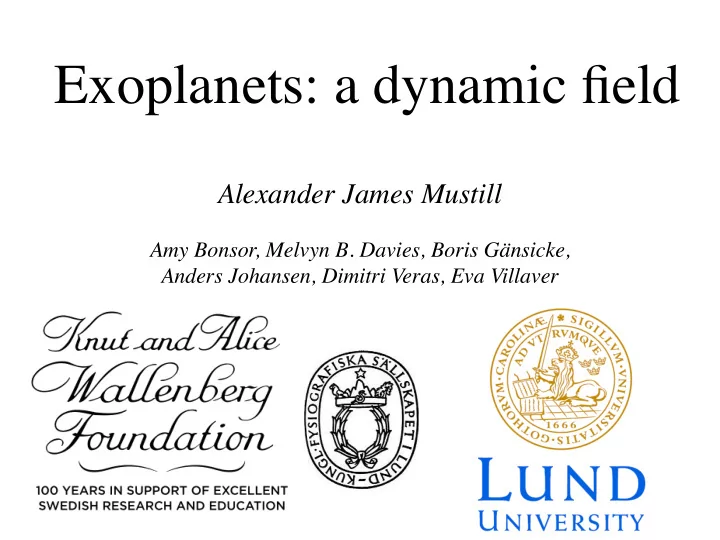

Exoplanets: a dynamic field Alexander James Mustill Amy Bonsor, Melvyn B. Davies, Boris Gänsicke, Anders Johansen, Dimitri Veras, Eva Villaver
The (transiting) exoplanet population Solar System Hot Jupiters: occurrence ~1% Super-Earths/ Neptunes: occurrence ~50% 0.1 au 1 au Lissauer et al 14
Orbital eccentricities often high: evidence of dynamical interactions
Planet–planet scattering Time until first close encounter in 3-planet systems • Planet’s gravity dominates in its Hill sphere (~Roche lobe) r H = a ( M pl /3 M ★ ) 1/3 • This is a region where strong scattering is possible: orbits change radically on < orbital timescales • Closely-spaced planets can experience this, with their separation (in Hill radii) setting the timescale for the onset of strong scattering Chambers+96
Scattering explains eccentricity distribution of giant exoplanets • Distribution well- reproduced if ~75-80% of giant planets form in unstable multi-planet systems ( e.g., Juric & Tremaine 08, Raymond+11) Raymond+11
Lidov–Kozai effect • Subclass of secular interactions occurring at high inclination HD80606b • Inclination and eccentricity couple together, conserving L z = [ a (1 – e 2 )] 1/2 cos I • Can drive e to very high values if starting from low- e , high- I state • Important for planets with a wide, inclined, binary stellar companion; and planets after scattering excites orbital eccentricities or inclinations Fabrycky & Tremaine 07
Tidal effects • When bodies (planets, stars, moons,…) are close, they feel a differential gravitational force across their volume • Distortion can lead to energy dissipation and an exchange of angular momentum between orbit and spin • Extremely strong function of physical radius/orbital separation • Severe distortion can result in a Roche = (3 M ★ / M pl ) 1/3 R pl total disruption of a body at the Roche limit = (3 ρ ★ / ρ pl ) 1/3 R ★
Star–planet tides: circularisation and orbital decay High e excited by perturber eccentricity Tide raised on planet by star dominates: orbital energy lost but orbital angular momentum constant Tide raised on star by planet dominates: orbital energy and angular momentum lost Planet disrupted by semi-major axis strong tidal force
Why hot Jupiters are single Solar System Hot Jupiters: occurrence ~1%, usually single or with wide-orbit ( ≳ 1au) companion Super-Earths/ Neptunes: occurrence ~50%, single or multiple 0.1 au 1 au Lissauer et al 14
High-eccentricity Hot Jupiter Migration Rasio & Ford 96, Wu & Murray 03, Fabrycky & Tremaine 07, Wu & Lithwick 11, Petrovich 15… Scattering/Kozai/secular Tidal circularisation
Destruction of any inner planets by high-eccentricity giants ~0.1 au Binary star 3 au Giant planet 3 super-Earths 100 au Mustill+15, 17
Loss of planets by stellar collision: potential cause of chemical enrichment • HD80606: star with eccentric proto-hot Jupiter ( a = 0.45 au, e = 0.93) and binary companion HD80607 (~1000au) • Binary can drive Kozai cycles on planet (Fabrycky & Tremaine 07) • HD80606 appears slightly metal-rich compared to HD80607 (Liu et al submitted) Fabrycky & Tremaine 07
Loss of planets by stellar collision: potential cause of chemical enrichment Liu et al submitted
Indirect evidence for planetary systems around white dwarfs (review: Farihi 16) • Spectroscopic signatures of metals accreted into ~40% flux of WD atmospheres λ • Dust discs detected flux through IR excesses λ • Gas discs detected through Keplerian emission flux features λ • Transits of disintegrating flux asteroids time
White Dwarf atmospheric abundances allow determination of planetary/asteroidal bulk composition Transit + RV = radius + mass Jura & Young 2014 ??? WD spectroscopy: detailed elemental breakdown
exoplanets.org | 3/28/2017 3.0 10 3 ♃ 2.5 Planet Mass [Earth Mass] Mass of Star [Solar Mass] Present-day Solar radius ♄ 100 2.0 ♆ ⛢ 10 1.5 Engulfed by giant star Survive engulfment ⊕ ♀ 1 1.0 ♂ ☿ Mustill & 0.5 0.1 Villaver 2012 survival limit 0.0 0.01 -3 0.01 0.1 1 10 100 10 Semi-Major Axis [Astronomical Units (AU)]
Effects of stellar evolution on planetary orbits • Mass loss causes orbits to expand • Conserve angular momentum L = [ GM ★ a (1 - e 2 )] 1/2 • If mass loss slow compared to orbital timescale, e is an adiabatic invariant • Orbits expand with a final / a initial = M ★ initial / M ★ final • Factor ~3 expansion for a typical 2M ⦿ progenitor • WD should be surrounded by a cleared volume of several au radius: how to get material to the surface?
Effects of stellar evolution on planetary orbits • Mass loss destabilises formerly stable systems (Debes & Sigurdsson 02) • Planetary dynamics set by planet:star mass ratio M pl / M ★ • Planets’ Hill spheres increase in size faster than orbits expand: r H = a ( M pl /3 M ★ ) 1/3 Mustill+14
Delivery of asteroids/comets to WD during and after planetary instability AGB tip instability Mustill+ submitted
Scattering by super-Earth planets well reproduces observed accretion rates Red: inner belt particles Blue: outer belt particles Are super-Earths as common on wide (>several au) orbits as they are on close- in (<1 au) orbits? Mustill+ submitted
Open questions • How representative are the simulated systems of real ones? • Effects of non-gravitational forces (radiation, gas drag,…) on the planetesimals • Circularisation of planets and planetesimals: compare to occurrence of transiting close-in bodies • How do the simulated scattering rates relate to the observed accretion rates? Material will collisionally process, and pass through the dust and gas discs… • Can all phenomena (accretion rates, disc properties, occurrence rates of transiting bodies) be quantitatively reproduced? • Postdoc wanted! Deadline 22 nd February!
Conclusions • Planetary systems are evolving, dynamic entities • Planet–planet or planet–star interactions can significantly change systems after their formation • High-eccentricity migration of hot Jupiters explains why they do not commonly have close companions • Stellar evolution can trigger qualitative changes in planetary dynamics • Wide-orbit super-Earth planets are a good candidate for delivering material to white dwarfs
Recommend
More recommend